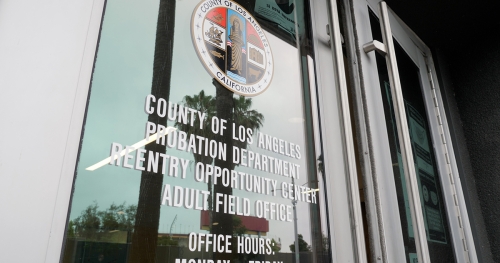An Intervention to Reduce Incarceration and Reincarceration Among Young Adults
Los Angeles County Reentry Integrated Services Project

Overview
Los Angeles County has the country’s largest jail and probation system, resulting in the need for a robust support system for individuals reintegrating into the community following a period of incarceration or supervision. In response, and with funding from the Safe Neighborhoods and Schools Act (Proposition 47) and California Community Corrections Performance Incentives Act of 2009 (Senate Bill 678), the LA County Justice, Care, and Opportunities Department (JCOD) offers a diverse set of programs designed to improve well-being and prevent future legal system involvement. These programs cover various needs, including employment services, skills training, and connections to community organizations that support people in reaching their goals following contact with the legal system.
For the Los Angeles County Reentry Integrated Services Project (LA CRISP), MDRC is collaborating with JCOD and the Council on State Governments. The purpose of the project is to understand the implementation and effects of JCOD programming on its participants and to make recommendations that will strengthen reentry services for people involved in the criminal legal system, including those on adult felony probation and those with mild or moderate mental health or substance use disorders.
Additional Project Details
Agenda, Scope, and Goals
LA CRISP is evaluating and providing research-driven technical assistance to the following six programs:
- Reentry Intensive Case Management Services (RICMS) program. Through a network of community-based providers located across LA County, the RICMS program links individuals at risk of legal system involvement to community health workers who provide care coordination and help clients navigate their way to a wide array of services and supports.
- Skills and Experience for the Careers of Tomorrow (SECTOR) program. SECTOR provides employment and training services in high-growth employment sectors, cognitive behavioral interventions, financial assistance, and connections to mental health and substance use disorder services to support people in developing a career pathway with family-sustaining wages.
- Innovative Employment Solutions (INVEST) program. Connects individuals under probationary supervision to programs run by the Department of Economic Opportunity to improve employment outcomes for the adult probationer population. The program aims to develop an effective model to deliver reentry employment services that lead to employment that is along an articulated career path.
- Developing Opportunities and Offering Reentry Solutions (DOORS) program. In order to reduce recidivism, DOORS seeks to address the barriers to successful reentry for individuals on adult felony supervision by streamlining linkages to support services. Two key features of the program are (1) co-location of service providers inside a probation field office, and (2) use of a program service-hub model in which multiple service providers have offices in the same space.
- Youth Overcoming (YO!) program. YO! is an age-responsive transformative mentoring program that serves young people aged 18-25 who are under probationary supervision. The program uses credible messenger mentoring combined with an evidence-based curriculum centered on cognitive behavioral principles to help adolescents reach developmental milestones and engage productively in education and work.
- Providing Opportunities for Women in Reentry (POWR) program. POWR provides gender-responsive, trauma-informed, and survivor-focused programming and services to women returning to the community, including women on adult felony probation. The program provides care coordination, systems navigation, cognitive behavioral intervention, job readiness and training services, and housing supports to women to account for the unique challenges that women who are system-involved face while taking advantage of other characteristics that are likely to encourage desistance.
Design, Sites, and Data Sources
MDRC is evaluating multiple programs within LA County JCOD’s system of reentry services for people involved in the criminal legal system or for those at risk of becoming involved in the future. Each evaluation uses a different combination of research methods that best aligns with each program’s design, state of implementation, and data availability. These methods include process studies to understand service coordination and service delivery, outcome and impact studies to identify the effects of reentry services on client outcomes, and cost studies to describe the financial costs and cost-effectiveness of reentry services and related funding streams.
Quantitative Methods
Administrative data used in the quantitative analyses come from the following sources:
- Management Information Systems for data on program referrals and participant needs and service receipt
- County Probation, Sheriff’s, and Superior Court Departments for data on arrests, charges, convictions, probation violations, and incarcerations
- County Department of Mental Health for data on behavioral and mental health services
- County Department of Economic Opportunity and California State Employment Development Department for data on employment and earnings
- County Department of Public Health’s Substance Abuse Prevention and Control for data on substance use treatment services
- Los Angeles Homeless Services Authority’s Homeless Management Information System for data on housing services
- County Department of Health Services for data on physical health care utilization
Information about who enrolled but did not participate (a consideration for forming a comparison group) and data availability informed the research designs for each evaluation. When possible, quasi-experimental impact analyses were conducted using such methods as instrumental variables and propensity score matching.
Qualitative Methods
To gather information about how each program operated across the network of grantee providers, MDRC used a combination the following approaches:
- Semi-structured interviews with staff members and administrators of service providers
- Observations of program operations
- Interviews or focus groups with program participants
- Review of written program materials
- Survey of program staff
Featured Work
A Review of the DOORS Program









